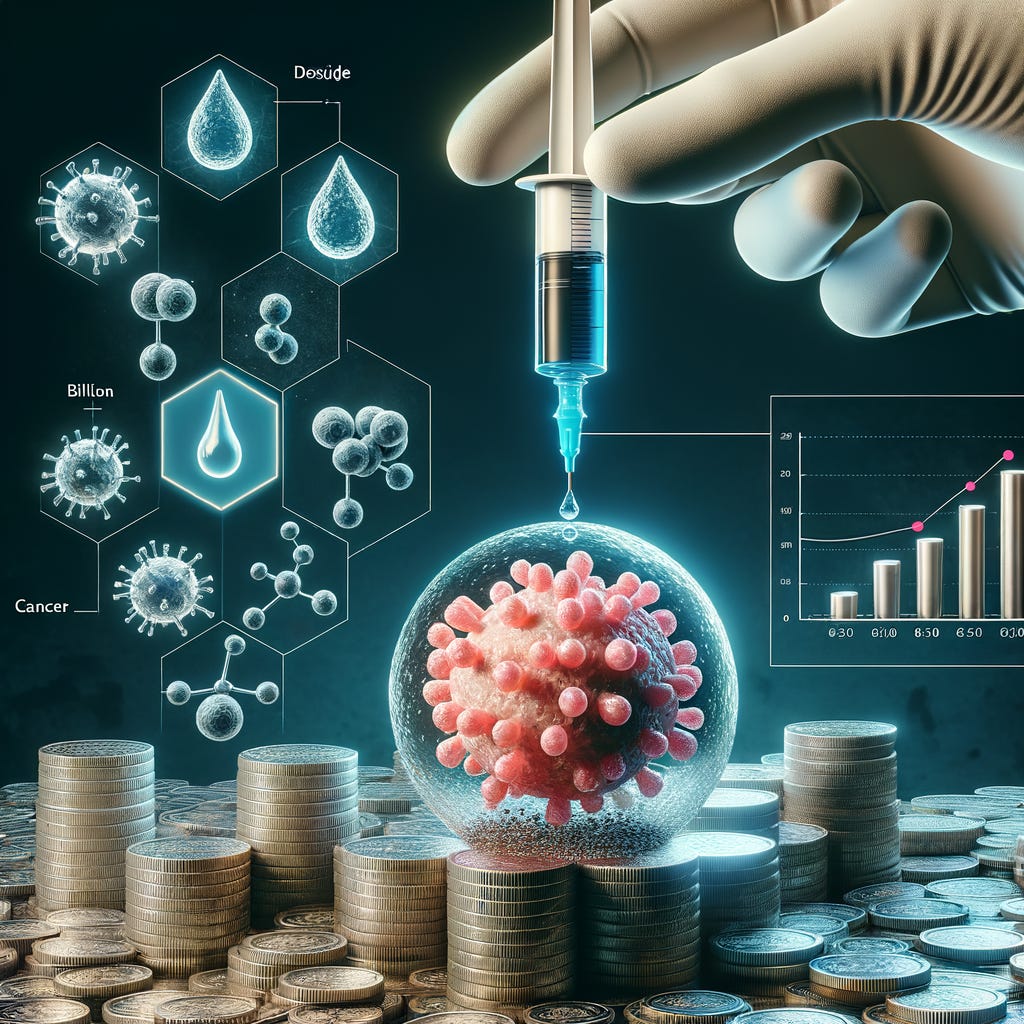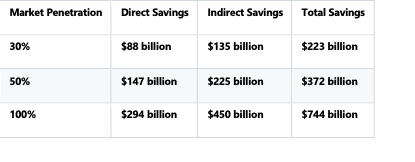Chlorine Dioxide Injection: A Groundbreaking Cancer Therapy That Could Save the U.S. Hundreds of Billions Annually
Cancer remains one of the most profound challenges to both global health and economic stability. In the United States alone, 2 million new cancer cases are diagnosed every year, with a staggering $380 billion spent annually on healthcare costs, lost productivity, caregiving, and other societal burdens. My innovative therapy, chlorine dioxide intratumoral injection, offers a revolutionary solution: curing cancer in a short timeframe, completely side-effect free, and drastically improving patients’ quality of life (QoL).
This blog will analyze the economic potential of this therapy, predicting its ability to transform cancer treatment and significantly reduce the overall social and economic costs of cancer in the U.S.
The Cost of Cancer in the U.S.: Breaking Down the Burden
Cancer treatment places a massive financial strain on both the healthcare system and the economy. The total societal cost consists of direct costs (medical expenses) and indirect costs (productivity losses, caregiving costs, and psychological tolls).
1. Direct Costs
Direct costs include all medical expenses related to the diagnosis and treatment of cancer:
Drug Costs: Targeted therapies and immunotherapies dominate cancer medication, often costing 100,000 to 300,000 annually per patient. Long-term treatment or combination regimens can increase these costs even further.
Hospitalization and Surgery Costs: Inpatient care and surgical interventions significantly add to the financial burden.
Nursing and Palliative Care Costs: These include end-of-life care, rehabilitation, and ongoing medical assistance.
Current Data:
The U.S. spends an estimated $210 billion annually on direct medical costs for cancer treatment, per data from the National Cancer Institute (NCI).
2. Indirect Costs
Indirect costs represent the economic impact of cancer on patients and society beyond direct healthcare spending. These include:
Productivity Losses: Cancer patients often leave the workforce due to illness or premature death.
Average productivity loss is 10,000−30,000 per year, depending on factors like disease stage, age, and role in the household.
Total productivity losses for cancer in the U.S. are estimated at $170 billion annually.
Family Caregiving Costs: Families bear the cost of caregiving for patients who are no longer self-sufficient.
Annual caregiving costs average 15,000−20,000 per patient.
Psychological Burdens: Cancer significantly reduces patients’ and families’ psychological well-being, manifesting in depression, anxiety, and overall reduced happiness and social engagement.
Why Chlorine Dioxide Therapy is a Game-Changer
The chlorine dioxide intratumoral injection therapy stands apart in its unique advantages:
Short-Term Cure: It rapidly eliminates cancer, sparing patients the need for prolonged therapies like chemotherapy, radiation, or long-term immunotherapy.
Side Effect-Free Treatment: Avoiding the fatigue, nausea, hair loss, and emotional toll common with traditional treatments, this therapy ensures a much higher QoL throughout the treatment process.
Significant QoL Improvement: Patients can resume normal lives, regaining full physical and emotional capacity shortly after recovery.
Cost-Efficient Solution: This therapy eliminates the need for ongoing treatment, creating massive long-term savings in healthcare costs.
Proposed Pricing:
The therapy is priced at $500,000 per patient, including five years of free follow-up care. While the upfront cost is higher than traditional therapies, its one-time nature and total eradication of the disease make it far more economical over time.
Economic Impact Analysis: Cost Savings from Chlorine Dioxide Therapy
Assuming 2 million new cancer cases in the U.S. annually, this analysis examines three levels of market penetration—30%, 50%, and 100%—and calculates the potential cost savings across both direct and indirect categories.
1. Direct Cost Savings
Direct costs dominate cancer treatment expenses. While this therapy’s upfront cost is higher, its ability to eliminate disease recurrence or prolonged treatment translates to significant long-term savings in:
Medication Costs: Reducing extended use of expensive therapies such as targeted or immunotherapies.
Hospitalization: Fewer inpatient visits and complications.
Caregiving: Less need for professional nursing or home-based care.
Estimated Direct Cost Savings:
Chlorine dioxide therapy reduces 70% of follow-up treatment costs, equaling an average savings of $147,000 per patient.
Total Direct Cost Savings:
30% market penetration (600,000 patients): $88 billion.
50% market penetration (1,000,000 patients): $147 billion.
100% market penetration (2,000,000 patients): $294 billion.
2. Indirect Cost Savings
(a) Productivity Losses Reduced
With a 90% cure rate, most patients can re-enter the workforce, restoring lost productivity.
Productivity savings per patient: 75,000 (annual productivity loss of 15,000 over 5 years).
Total Savings:
30% penetration: $45 billion.
50% penetration: $75 billion.
100% penetration: $150 billion.
(b) Caregiving Costs Alleviated
Healing patients eliminates the dependency on families for care, cutting household caregiving expenses.
Savings per patient: $100,000 over 5 years.
Total Savings:
30% penetration: $60 billion.
50% penetration: $100 billion.
100% penetration: $200 billion.
(c) Psychological Value Recovered
This therapy’s ability to restore health and avoid painful side effects significantly improves patients' and their families' psychological well-being. By assigning a modest monetary value to this improvement:
Psychological savings per patient = $50,000.
Total Savings:
30% penetration: $30 billion.
50% penetration: $50 billion.
100% penetration: $100 billion.
3. Total Cost Savings
Adding direct and indirect costs together gives us the following total savings:
Chlorine Dioxide Therapy: A Revolutionary Solution
A Cure Without the Pain: This therapy eliminates cancer in a short amount of time, avoiding the long-term suffering associated with traditional treatments.
Unmatched Quality of Life: Patients no longer battle debilitating side effects, improving both their time in treatment and their post-recovery experiences.
Economic Sustainability: With the potential to save up to $744 billion annually at full market penetration, this therapy offers far-reaching benefits for patients, insurers, and society as a whole.
Social and Psychological Impact: Patients and their families escape the emotional toll of cancer, regaining happiness and peace of mind.
Conclusion
Chlorine dioxide therapy has the potential to transform cancer care worldwide, not just in terms of improving health outcomes but also revolutionizing the economics of healthcare. Even at a conservative 30% market penetration rate, the therapy could save $223 billion annually, a nearly 60% reduction in total societal costs for those whom it treats.
This innovative approach represents not only a medical breakthrough but a new standard for what cancer treatments can achieve. By curing cancer effectively, without side effects, and with long-lasting benefits for patients and families, it paves the way for a brighter and more sustainable future in healthcare.






I got rather excited when I started reading this newsletter. My husband has stage 4 mets prostate cancer. Is he too far along to be treated with this? Also, are you saying that patients would have to cough up $500,000? How many people have that kind of cash available? I have to say, my heart sank when I read that part.
In December my husband was diagnosed with p16 squamous cell carcinoma.
We’re starting “treatment” Monday. But I would have preferred to try your method.
Please keep us informed as you’re doing with where and who can help people like us.
I should have asked if we could come to where you are. Or if you know of someone in the states who would be willing to try. (Or anywhere else).
We’ve been trying to use ingested ClO2 to aid our health. But we have t had the results we needed (for my husband).
I think you’re extremely generous for sharing your work with such detail and I want to send a serious “thank you” to you